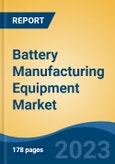Lithium Ion is the fastest growing segment, North America is the largest regional market
Speak directly to the analyst to clarify any post sales queries you may have.
10% Free customizationThis report comes with 10% free customization, enabling you to add data that meets your specific business needs.
Key Market Drivers
The rapid growth in electric vehicle adoption and the global expansion of battery manufacturing capacity stand as primary accelerators for the battery manufacturing equipment market. The escalating demand for electric vehicles has directly translated into increased requirements for advanced battery production machinery. According to the IEA's Global EV Outlook, in April 2024, global electric car sales were projected to reach 17 million units by the end of 2024, reflecting a substantial and ongoing market shift towards electric mobility. This significant uptake necessitates a corresponding scale-up in battery production facilities worldwide.Key Market Challenges
A significant challenging factor within the global battery manufacturing equipment market is the substantial capital expenditure required and the inherent technological complexity associated with establishing and continually upgrading advanced production facilities. This necessitates considerable financial commitment, which can act as a barrier to entry for new market participants and limit the expansion capabilities of existing manufacturers. Investing in advanced machinery for electrode production, cell assembly, and rigorous testing requires immense upfront costs.Key Market Trends
The evolution of specialized equipment for solid-state battery production represents a significant trend in the global battery manufacturing equipment market. Unlike conventional lithium-ion batteries, solid-state designs necessitate distinct manufacturing processes and machinery to handle solid electrolytes and novel electrode materials, which often require precise atmospheric control and advanced pressing techniques. The Electrochemical Society, in February 2024, highlighted that solid-state electrolytes have emerged as promising candidates for next-generation batteries, driving intense research and development in this area. This shift fuels demand for innovative equipment capable of forming dense solid electrolyte layers and ensuring stable interfaces.Key Market Players Profiled:
- ABB Ltd
- Robert Bosch GmbH
- Bühler AG
- Durmazlar Machinery Inc
- Eisenmann GmbH
- Engis Corporation
- Ficep S.p.A.
- Foshan Golden Milky Way Intelligent Equipment Co., Ltd.
- Hegenscheidt MFD GmbH
- Hitachi, Ltd
Report Scope:
In this report, the Global Battery Manufacturing Equipment Market has been segmented into the following categories:By Machine Type:
- Coating and Dryer
- Calendaring
- Slitting
- Mixing
- Electrode Stacking
- Assembly and Handling Machine
- Formation and Testing Machine
By End User:
- Automotive
- Industrial
- Other
By Battery Type:
- Lead Acid
- Lithium Ion
- Nickel Metal Hydride
- Nickel Cadmium
- Others
By Region:
- North America
- Europe
- Asia-Pacific
- South America
- Middle East & Africa
Competitive Landscape
Company Profiles: Detailed analysis of the major companies present in the Global Battery Manufacturing Equipment Market.Available Customizations:
With the given market data, the publisher offers customizations according to a company's specific needs. The following customization options are available for the report.Company Information
- Detailed analysis and profiling of additional market players (up to five).
This product will be delivered within 1-3 business days.
Table of Contents
Companies Mentioned
The companies profiled in this Battery Manufacturing Equipment market report include:- ABB Ltd
- Robert Bosch GmbH
- Bühler AG
- Durmazlar Machinery Inc
- Eisenmann GmbH
- Engis Corporation
- Ficep S.p.A.
- Foshan Golden Milky Way Intelligent Equipment Co., Ltd.
- Hegenscheidt MFD GmbH
- Hitachi, Ltd
Table Information
| Report Attribute | Details |
|---|---|
| No. of Pages | 181 |
| Published | November 2025 |
| Forecast Period | 2024 - 2030 |
| Estimated Market Value ( USD | $ 8.57 Billion |
| Forecasted Market Value ( USD | $ 36.68 Billion |
| Compound Annual Growth Rate | 27.4% |
| Regions Covered | Global |
| No. of Companies Mentioned | 11 |









